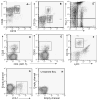Screening monoclonal antibodies for cross-reactivity in the ferret model of influenza infection
- PMID: 18485358
- PMCID: PMC2446606
- DOI: 10.1016/j.jim.2008.04.003
Screening monoclonal antibodies for cross-reactivity in the ferret model of influenza infection
Abstract
Influenza virus infections carry a high public health cost, and pandemics are potentially catastrophic. Though the ferret is generally regarded as the best model for human influenza, few reagents are available for the analysis of cellular immunity. We thus screened monoclonal antibodies (mAbs) made for identifying immune cells in other species to see if any were cross-reactive. Flow cytometric analysis of lymphocytes isolated from blood, spleen, and lung of normal and virus-infected ferrets indicated that several mouse mAbs bound to the corresponding antigens in ferrets. Typing bronchoalveolar lavage populations from pneumonic ferrets with mAb to human CD8 showed the massive CD8+ T cell enrichment characteristic of this infection in mice. The availability of this, and several other mAbs that showed cross-reactivity, should allow us to begin the dissection of cell-mediated immunity in the ferret, which, at least from these early results, looks similar to the situation in mice.
Figures




References
-
- Aasted B. Mink infected with Aleutian Disease Virus have an elevated level of CD8-positive T lymphocytes. Vet Immunol Immunopath. 1989;20:375–385. - PubMed
-
- Brodersen R, Bijlsma F, Gori K, Jensen KT, Chen W, Dominguez J, Haverson K, Moore PF, Saalmuller A, Sachs D, Slierendrecht WJ, Stokes C, Vainio O, Zuckerman F, Aasted B. Analysis of the immunological cross reactivities of 213 well characterized monoclonal antibodies with specificities against various leucocyte surface antigens of human and 11 animal species. Vet Immunol Immunopath. 1998;64:1–13. - PubMed
-
- Cabezas JA, Calvo P, Eid P, Martin J, Perez E, Reglero A, Hannoun C. Neuraminidase from influenza A virus A (H3N2): specificity towards several substrates and procedure of activity determination. Biochim Biphys Acta. 1980;616:228–238. - PubMed
Publication types
MeSH terms
Substances
Grants and funding
LinkOut - more resources
Full Text Sources
Research Materials

